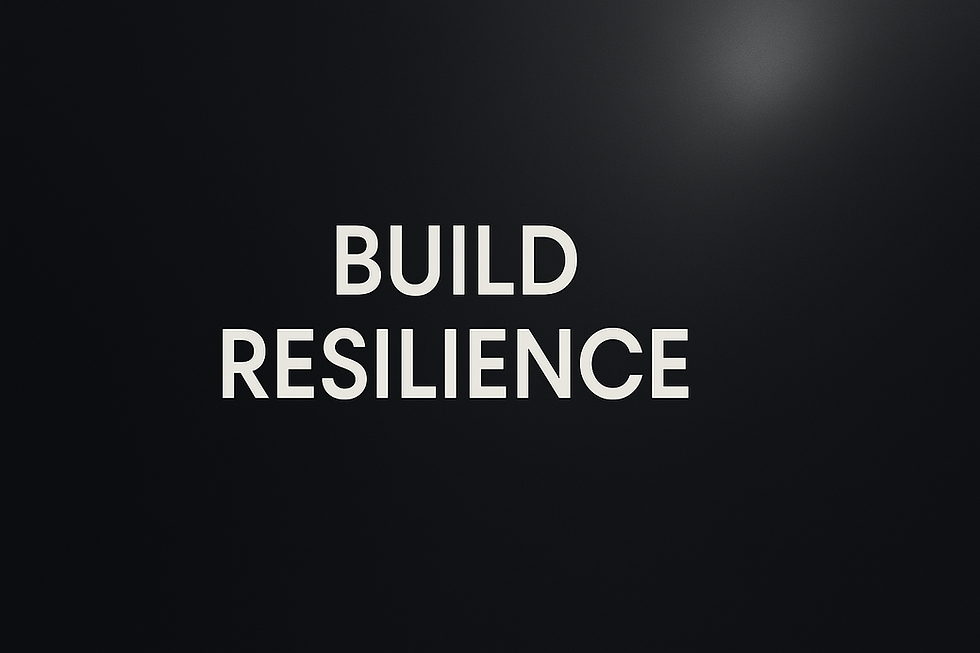How to Build Resilience : Stay Strong Under Pressure
- Aedesius

- May 18
- 3 min read
Updated: Sep 25

Resilience isn’t about being unbreakable. It’s about learning how to recover-faster, clearer, and wiser. In life, stress is not optional. But collapse is. Whether you’re dealing with setbacks, failure, pressure, or uncertainty, building resilience is what helps you stand back up.
This guide draws on psychological research, real-world applications, and reflective strategies used by high-performing individuals across disciplines-from health care and education to sports and entrepreneurship.
What Is Resilience?
Resilience is the ability to adapt during difficulty and return to stability after stress. It doesn’t mean you never struggle. It means you keep going through the struggle.
According to the American Psychological Association, resilience is not a trait people either have or do not have. It involves behaviors, thoughts, and actions that can be learned and developed in anyone.
You may face loss, rejection, burnout, or disappointment. What defines resilience is what happens next.
Resilience Meaning in Daily Life
Responding rather than reacting to stress
Staying grounded when plans fall apart
Seeing challenges as growth opportunities rather than permanent obstacles
Why Is Resilience Important?
You can’t always control what happens to you, but you can control how you respond. Resilient people don’t get stuck in setbacks. They reflect, adjust, and continue. That’s the difference.
Benefits of Resilience
Emotional strength - Reduced anxiety and depression under pressure
Cognitive clarity - Better decision-making in high-stress moments
Goal consistency - Staying aligned with long-term vision despite short-term pain
Professionals with high resilience are more likely to recover from burnout, perform well in leadership roles, and maintain well-being in demanding environments.
How to Build Mental and Emotional Resilience
Resilience is trainable. You don’t have to be born with it. The following methods are backed by cognitive behavioral therapy, mindfulness research, and real-life results.
Strengthen Your Thinking
Thoughts shape how you feel. When you hear yourself say “I can’t do this,” pause and reframe: “This is hard, but I can handle it.” Over time, these micro-adjustments shift your inner dialogue into one that builds instead of breaks.
Simplify the Next Step
During crisis, overwhelm is your enemy. Break goals into the next step only. Make progress small and repeatable. This keeps your nervous system engaged but not overloaded.
Build a Recovery Plan
The best performers don’t avoid stress-they recover from it better. Set intentional daily and weekly practices to recharge:
10 minutes of walking
Intentional screen breaks
Journaling emotional triggers
Deep breathing before sleep
Regulate Emotion Without Suppression
Healthy resilience doesn’t ignore emotion. It names it. Label your feelings out loud or on paper. Studies show that naming emotion lowers its intensity in the brain and helps restore calm faster.
Emotional Resilience vs Mental Resilience
Understanding the difference sharpens your self-awareness:
Emotional resilience helps you process feeling. It’s about staying grounded without shutting down.
Mental resilience supports logic and focus under pressure. It helps you think clearly when decisions matter most.
Resilient people tend to strengthen both, often through the same habits: reflection, reframing, and restorative rest.
Examples of Resilience in Practice
Healthcare workers maintaining calm and clarity during emergencies through breathing techniques and peer support
Entrepreneurs who use failure data to pivot their strategy instead of quitting
Students who adapt study habits after exam failure and outperform later assessments
Parents who pause, reset, and re-engage during difficult child-rearing moments
These are not heroic breakthroughs. They are small, repeated acts of emotional skill.
Expert Insight: What Research Says
A study published in the journal Emotion (2011) found that individuals who engage in regular reappraisal (thinking differently about stressful events) show higher resilience and lower emotional exhaustion.
Similarly, the Journal of Occupational Health Psychology highlights that employees with resilience training reported reduced burnout and improved work-life satisfaction.
These findings suggest that simple mental tools-like self-talk, mindfulness, and perspective shifts-aren’t soft skills. They’re performance assets.
How to Begin Building Resilience Today
Start small and specific. You don’t need a life overhaul. You need a system that holds under pressure.
Name your stressor - Write it down. Say it out loud.
Take one breath - Literally. Reset your nervous system.
Choose one next move - Not the perfect move. Just the next one.
Repeat daily. Stack small acts. That’s how resilience forms.
Final Thought
Resilience doesn’t mean you never fall. It means you know how to rise.
Don’t wait for calm conditions to build this skill. Practice it in the small frictions of daily life.
Breathe. Adjust. Act.
That’s how you build resilience that holds.
